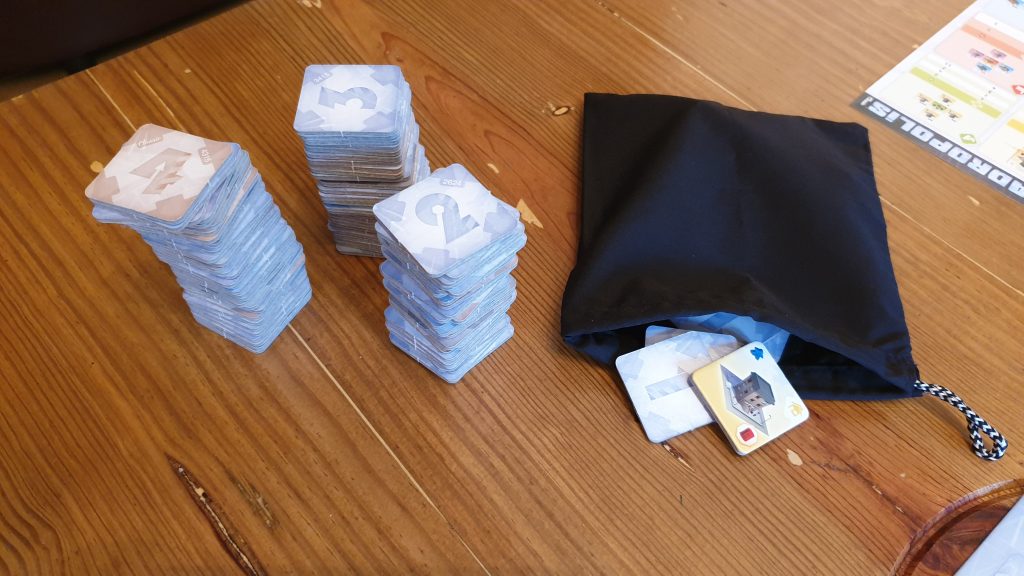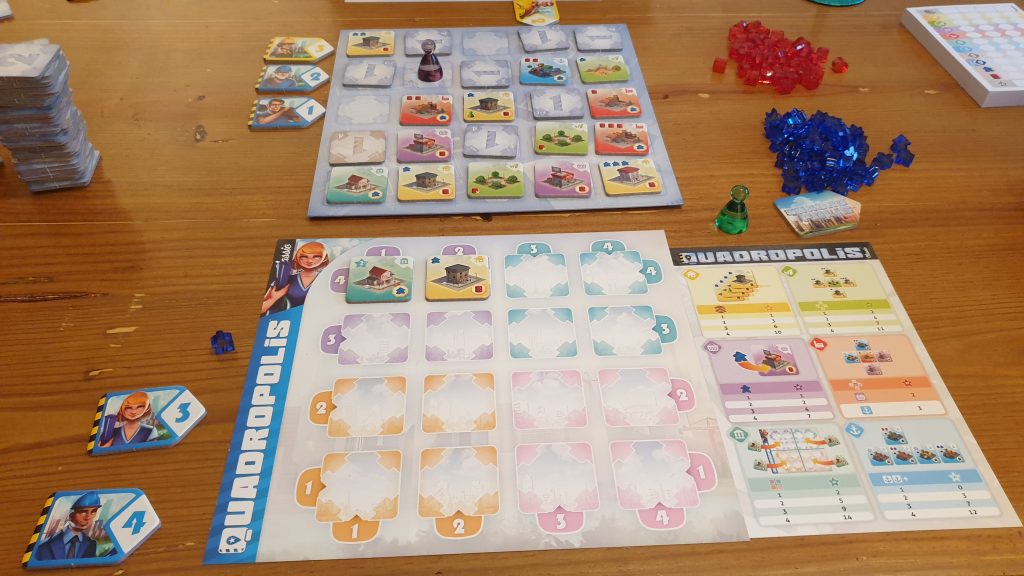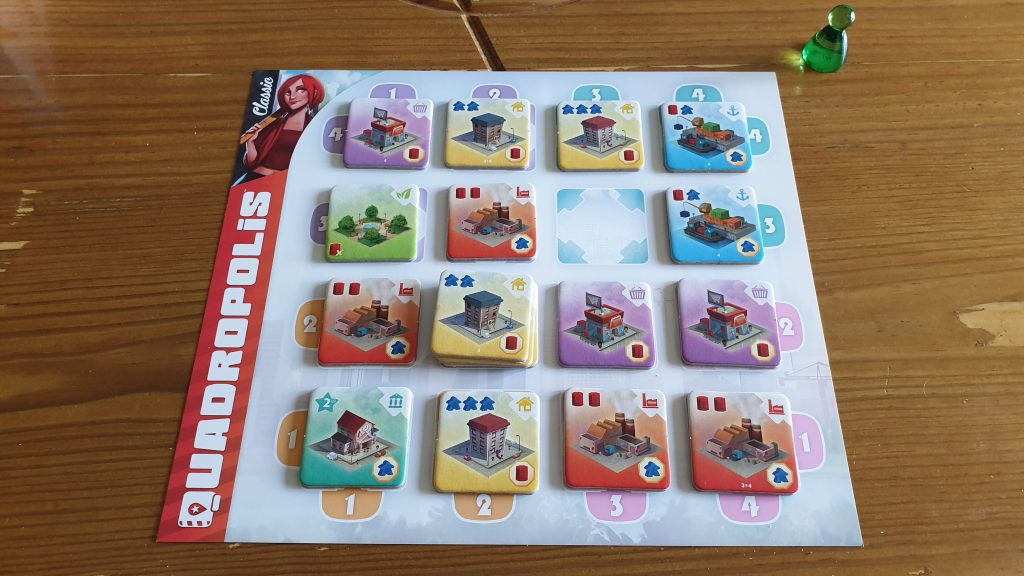Quadropolis is a city building, tile placement board game, released back in 2016 by Days of Wonder. Designed by François Gandon, featuring artwork from Cyrille Daujean and Sabrina Miramon, the game sees 2 – 4 players become mayors for around 45 minutes. These mayors will be competing to get green parks, shops, tower blocks and more constructed all while having the energy production and population to use what is built. However, is there something that builds enjoyment as well as a city? Let’s find out!
Setup for the first game is a bit slow, though thanks to the insert it is much quicker in future games. Players take their player boards and architect tokens from the box. Resource piles of energy and people are made within reach. Then, the four sets of tiles for the four rounds are placed within reach.
Unlike most games that have titles only for specific player counts all round 1 tiles go into the bag. Tiles are then randomly drawn and placed face down onto the central grid, the construction site board. Now the player count rules come into effect, with only the appropriate tiles flipped face up. Placing the Urbanist pawn next to the board and passing the Mayor pawn to the starting player the game is ready.

Each mayor will be building their own city on their player boards but what they are building will come from the central construction board. Lasting four rounds each round players will get 4 tiles. This is done on a turn by placing one of their four architects next to the central board. Architects have a value on them of 1 – 4, representing two important things. Firstly, the number represents how far into the column or row the player takes a tile from. The Urbanist pawn is then moved there, blocking that row and column for the next player.
Next, the architect number dictates where on their personal player board the tile may be placed. For example, when playing the “2” architect to choose a tile it can be placed in either the 2 column or 2 row on their player board. If no spot is free to place it – or if the player wishes to – the tile is simply discarded not placed. The only exception are tower blocks. Unlike other building types these can stack and the architect number can also be the new height of the stack it is going on top of.
Whenever a building is placed if it denotes resources in the top left corner – either people or energy – these are taken from the reserve. Play then moves onto the next player and the round continues until each player has played their four architects. At this point if anyone took the special tower block with the first player marker symbol they claim it to start the next round. Setup between rounds is identical to the beginning of the game but with the next rounds tiles. At the end of the four rounds it is time to activate buildings and score points!

All tiles activate the same way. In the bottom right tiles have an indicated resource which must be placed there to activate the building. Having a slight difference again are tower blocks where only the top most tile needs to be activated for the stack to score. None of the scoring objectives are complicated, not even the expert variant buildings. The majority score based on how they are positioned on the grid or what they are adjacent to. These range from parks with tower blocks next to them to the number of harbours in a row. Some tiles even come with victory points on them which are awarded only if activated. Once all the building types have been scored the person with the most points wins.
Quadropolis is a puzzle that won’t truly click until near the end of the first game. Even after a couple of games the exact way the choice of architect impacts the game was still a little lost on me. You’ll constantly have to balance the short term gain of a building with the long term problems a placement causes for the future. There are some tricks to pick up like the way stacking tower blocks can help to circumvent placement problems. Then, when everyone has cottoned onto this tower blocks become a hot commodity and an interesting meta begins.
In terms of being a puzzle once cracked the game does lose some of its shine. The expert variant goes some way to fixing this. It replaces a small number of tiles each round to increase the variety of building types. In an interesting way Quadropolis is both a brain burning title and a simple uncomplex game. The expert variant removes a little too much of the simple side of the title which sees some analysis paralysis creep into turns – something that only gets worse as the game progresses and the importance of the decisions seems higher.

In terms of player count the setup is handled very well, with it being a personal bugbear when at the start of a game you have to sort through and remove tiles or cards based on player count. This being said, two or three players is where the game pace is nicely maintained, with limited downtime. This is mostly due to the amount the construction site changes between turns. With four players it is extremely hard to plan future turns as three tiles will be taken, three slots around the edge and only on the previous players turn will you find out the location of the Urbanist. Whilst this is present in 2/3 player games it isn’t to the same extent. Effectively you can try to make choices before your turn begins rather than wait until it’s your turn to even determine your options.
The player boards are thin and are a slight worry for long term play – in spite of them currently showing no signs of wear. This is only made more obvious by the rather thick tiles for the buildings. Aside from this oversight the boards work perfectly to avoid some potential fiddliness. With a decent spacing between buildings, be it on the 4×4 or 4×5 grid, there isn’t the annoying alignment issues or trying to squeeze tiles into gaps. This does however have a downside. The city plan doesn’t quite build up as one. While placements are obviously adjacent it does not creating a flowing city. It could have portrayed a bright and vivid city, the colour palette is certainly there.
Days of Wonder rarely produce a “miss” and they haven’t with Quadropolis. It is a puzzle that changes from game to game, adapts nicely to different player counts and is relatively pretty on the table. Nevertheless, the game slows with over three players and you feel like you have much less control over the puzzle you’re trying to solve. Other than the architect tile choice the game does little to stand out from the crowd. It is a good core but one that will see the game be played a few times rather than for a few years. Simply, Quadropolis misses the wow factor to be called great.
[Editor’s note: Quadropolis was provided to us by Asmodee for review purposes. The game is currently available on 365 Games for £29.69. It is also available from local board game stores, find your local store here]

